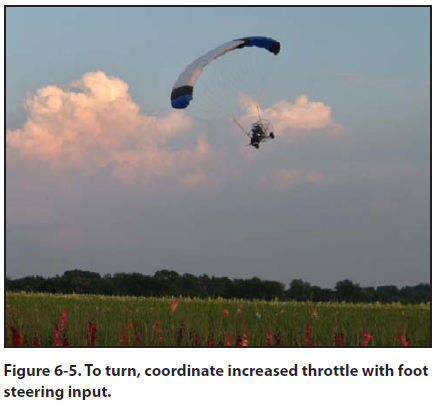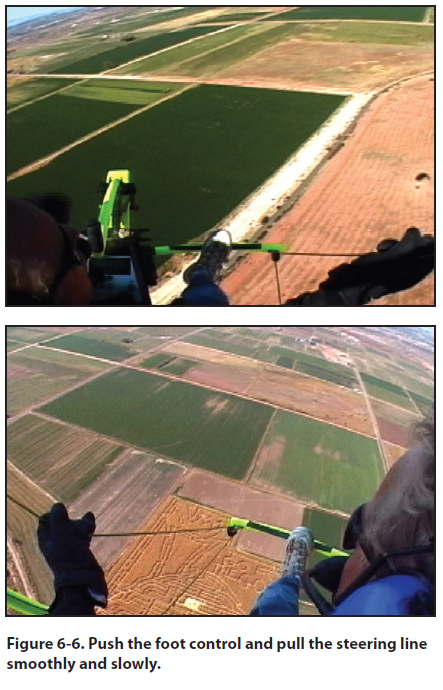|
Chapter 6 — Basic Flight Maneuvers
Level Turns
A turn is made by banking the wing in the direction of
the desired turn. A specific angle of bank is selected
by the pilot, control pressures applied to achieve the
desired bank angle, and appropriate control pressures
exerted to maintain the desired bank angle once it is
established.
Both primary controls are used in close coordination
when making level turns. Their functions are as follows.
• The steering bars bank the wings and so
determine the rate of turn.
• The throttle determines vertical speed and must
be increased during a turn for the PPC to remain
level. The greater the degree of turn, the greater
the throttle/thrust required to remain level; this
is similar to an airplane and weight-shift control
aircraft.
For purposes of this discussion, turns are divided into
three types: shallow, medium, and steep.
• Shallow turns are those in which the bank is
less than approximately 20°.
• Medium turns are those resulting from
approximately 20° to 45° of bank.
• Steep turns are those resulting from 45° or
more of bank. Steep turns are generally not
recommended in a PPC.
Bank angle is measured in a PPC from angle of the
horizon and any level component on the PPC, typically
the instrument panel, steering bars, cart frame, or
any other cart component that can provide a horizontal
reference. Each design will have its own unique
reference.
Exceeding the limitations specified in the regulations
or in the aircraft pilot operating handbook is considered
aerobatics and not authorized by the manufacturer
limitations.
To initiate a turn, drag is created on the side of the
wing you want to turn via the steering control bar,
slowing and dropping that wing into the desired bank.
The side without the drag is flying faster and hence
pivots around the slower side. As discussed in Chapter
2, the PPC is designed to track directly into the
relative air stream, similar to a weight-shift control
aircraft. Therefore, no rudder is needed to coordinate
a turn.
A shallow bank produces a noticeable turn but you
likely will not notice an increase in load or airspeed.
A constant pressure is required on the steering bar to
maintain the bank angle for the turn. Abruptly releasing
the pressure on the foot bar would typically bring
the PPC back to straight flight because the pendulum
effect is so minor.
A medium bank turn requires more PPC performance
than a shallow bank. Higher and noticeable loads,
plus noticeable airspeed increases are the result of
a medium bank turn. After the bank has been established
in a medium banked turn, pressure on the
steering control must be maintained to continue the
bank. If the control pressure is released, the PPC will
return to the level position because of the pendulum
stability discussed in Chapter 2. If it is a medium bank
angle, such as 40 degrees, and the pressure is released
abruptly, there will be some dampening oscillations
until the PPC returns to level flight. Slower responses
are required so the bank angle is reduced gradually
to maintain “coordinated pendulum effect.” All PPCs
have unique flying characteristics, but generally, lower performance “rectangular” wings would dampen
quicker than higher performance “elliptical” wings.
To maintain altitude during a turn, you must directly
coordinate the amount of steering input with the
amount of throttle increase because of the loss in vertical
lift, as covered in Chapter 2. To make a shallow
turn, only a modest amount of steering control input
and throttle increase is required. As the steering input
is applied, you will also simultaneously apply the
corresponding amount of throttle increase to maintain
level flight throughout the turn.
The greater the bank angle, the greater the throttle required
to remain in level flight. Also, with increased
bank, greater skill is required to reduce the pendulum
effect when coming out of the turn or reversing the
direction of the turn. [Figure 6-5]

To stop the turn and return to straight-and-level flight,
you need to smoothly release the steering control
input to achieve pendulum effect coordination. The
pendulum stability of the PPC will do the rest to return
to the straight flightpath.
All PPC controls should be manipulated with a smooth
and slow motion. This will prevent pilot induced oscillation
(PIO). Whether you are pushing the throttle
forward to increase the pitch angle, or pushing the
steering control to induce a turn, both controls should
be operated smoothly and slowly—whether applying
input or removing it. [Figure 6-6]

The rate at which a PPC turns is directly related to
the amount of steering control input. The more input,
the quicker the rate of turn. Be advised, however, if
full steering input is used and adequate throttle is not used to compensate, the vertical component of lift is
reduced significantly and a rapid descent will ensue as
the turn progresses.
Common Errors for Level Turns
• Failure to adequately clear the area before
beginning the turn.
• Attempting to sit up straight, in relation to the
ground, during a turn, rather than maintaining
posture with the cart.
• Insufficient feel for the PPC.
• Gaining proficiency in turning in only one
direction; not practicing turns in both directions.
• Failure to coordinate the throttle with the
steering controls.
• Altitude gain/loss during the turn.
• Too great of a bank angle.
|

